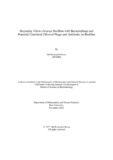| dc.contributor.advisor | Bin Naser, Iftekhar | |
| dc.contributor.author | Hasan, Md Rockybul | |
| dc.date.accessioned | 2023-04-13T08:24:06Z | |
| dc.date.available | 2023-04-13T08:24:06Z | |
| dc.date.copyright | 2022 | |
| dc.date.issued | 2022-11 | |
| dc.identifier.other | ID: 20376002 | |
| dc.identifier.uri | http://hdl.handle.net/10361/18148 | |
| dc.description | This thesis report is submitted in partial fulfillment of the requirement for the degree of Master of Science in Biotechnology, 2022. | en_US |
| dc.description | Cataloged from PDF version of thesis. | |
| dc.description | Includes bibliographical references (pages 40-47). | |
| dc.description.abstract | Vibrio cholerae is a gram-negative coccobacillus known as the causative agent of cholera- a
gastrointestinal disease endemic to developing and underdeveloped countries, Bangladesh
being one of them. The ability to form biofilms made it very difficult for many broad host range
antibiotics to penetrate through them and destroy them completely. The cells in the biofilm can
persist in a wide range of environmental conditions by remaining metabolically dormant and
able to resuscitate into planktonic cells after getting suitable opportunities which can lead to a
cholera outbreak. Antibiotics have been used to breakdown biofilms, however the attempts
remained unsuccessful in most cases even if the concentration is a few times higher compared
to the planktonic counterpart of the same bacteria. In this study, bacteriophage therapy was
introduced as an alternative to antibiotic treatment for degrading V. cholerae biofilms.
Combined treatment of phage and antibiotic (kanamycin) was performed to check the
effectiveness in degrading biofilms and killing the planktonic bacteria at the same time. In both
cases of single phage and combination treatment there were evidence of decreasing the
biofilm layers of Vibrio strains but not when treated with kanamycin alone. Shiga Toxin
producing E. coli (STEC) was used to screen the phage’s ability to target hosts other than
Vibrio strains, which turned out to be ineffective. There is potential scope to use combined
phage and antibiotic therapy in regulating biofilm formation, but further investigation and risk
evaluation is required | en_US |
| dc.description.statementofresponsibility | Md Rockybul Hasan | |
| dc.format.extent | 49 pages | |
| dc.language.iso | en | en_US |
| dc.publisher | Brac University | en_US |
| dc.rights | Brac University theses are protected by copyright. They may be viewed from this source for any purpose, but reproduction or distribution in any format is prohibited without written permission. | |
| dc.subject | Vibrio cholerae | en_US |
| dc.subject | Biofilms | en_US |
| dc.subject | Bacteriophage | en_US |
| dc.subject | Antibiotic | en_US |
| dc.subject.lcsh | Vibrio cholerae. | |
| dc.title | Degrading Vibrio cholerae Biofilms with Bacteriophage and potential combined effect of phage and antibiotic on biofilms | en_US |
| dc.type | Thesis | en_US |
| dc.contributor.department | Department of Mathematics and Natural Sciences, Brac University | |
| dc.description.degree | M. Biotechnology | |

